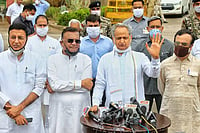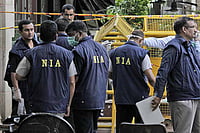Nirmala Sitharman presented the Union Budget 2022-23 on Tuesday. And this time she took a digital tablet wrapped in a traditional bahi khata style pouch as she headed for Parliament. She posed for the traditional 'briefcase' picture outside her office along with her team of officials before heading to meet the President. She presented the budget in a digital format.
Over the years, Sitharaman has ditched the traditional briefcase and made several shifts through ‘bahi khata’ to Made-in-India tablet. The tab was wrapped in the traditional red cloth with a golden emblem of the Indian government on it.

On Twitter, the official page of Digital India tweeted,“#AatmanirbharBharatKaBudget | From 'Bahi Khata' to ‘Made in India' Tablet Finance Minister @nsitharaman carrying the Budget in the #paperless format in a tablet kept inside a red cover with National Emblem embossed on it instead of the briefcase or 'Bahi Khata'.”
Sitharaman, India's first full-time woman Finance Minister, had in July 2019 ditched the colonial legacy of a Budget Briefcase for the traditional Bahi-Khata to carry Union Budget Papers. She used the same in the following year, and in a pandemic-hit 2021, she swapped traditional papers with a digital tablet for carrying her speech as well as other Budget documents.
In 2019, when Narendra Modi was re-elected as the Prime Minister, Sitharaman was appointed the finance minister then. When she had presented her maiden budget on July 5, 2019, she had carried a red-clothed folder enclosed with a string and emblazoned with the national emblem to carry the Budget documents.
The long tale of the budget briefcase in India
The word ‘budget’ originates from the French word ‘bougette’, which means a leather briefcase,
The tradition of carrying a briefcase during a budget presentation was inherited from British colonial rule. India’s budget briefcase was created to replicate the ‘Gladstone box’, which is used by the Chancellor of Exchequer (equivalent to India’s finance minister) to present the budget. It was named after the British budget chief of 1860, William E Gladstone, who sued a red suitcase to carry his papers and the box had the golden monogram of the Queen embossed on it.
While in Britain, the briefcase is passed down from one minister to the other, in India, different finance ministers have carried their own briefcases.
India’s first finance minister RK Shnamukhan Chetty had carried a leather briefcase for the first Budget presentation in 1947.
Sitharaman ditches colonial briefcase
Earlier, finance ministers in different governments, including her predecessors in the Modi government - Arun Jaitley and Piyush Goyal, used the standard Budget briefcase.
However, in 2019, Sitharaman ditched the archaic briefcase to carry her Budget papers in a ‘bahi khata’ style. Commenting on the switch from briefcases, Sitharaman had said, “I changed it because the suitcase immediately gave me a negative connotation. I knew this government was never about the briefcase business."

The bahi khata made a reappearance in 2020, only for the last time. In 2021, Sitharamans switched to a Made-in-India pad, to make a paperless presentation in view of the pandemic pushing the world to a digital era.
In 2022, the Sitharaman continued with her presentation in the digital style, as she walked inside the Parliament with the Made-in-India pad.
(with inputs from PTI)


























